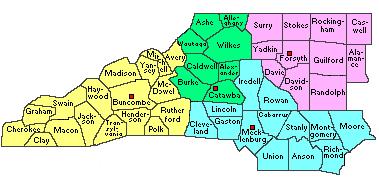
Teams Assessing Damage in Western North Carolina
RALEIGH -- PRESS RELEASE -- NC Roy Cooper Survey by local, state and federal experts next step in helping the region recover
June 5, 2018
State and federal emergency management experts are in western North Carolina to begin surveying destruction caused by last week’s torrential rains and mudslides to determine what help individuals and communities may need to recover, Governor Roy Cooper said Tuesday.
The damage assessments underway this week will help determine if any state or federal aid may be available to help individuals and communities hit hard by the storm. The federal government would determine whether or not storm-impacted areas in North Carolina qualify for federal disaster recovery funds.
“Western North Carolina has been pummeled by relentless rain in the past two weeks with many areas getting nearly two feet of rain,” Governor Roy Cooper said. “We know it will take these communities time and support to recover, and experts are on the ground now to survey the damage and see what help is needed.”
Local officials conducted initial damage assessments over the weekend. State and local emergency managers met Monday to discuss the damage assessment process, and today teams comprised of local, state and federal emergency managers will canvass impacted communities to survey damages. The teams expect to complete their assessments next week.
Once they compile the amount and type of damage, emergency management officials can determine whether any areas may qualify for financial assistance from the state and federal government.
Damage assessments are taking place in multiple impacted counties in western North Carolina as well as the lands of the Eastern Band of Cherokee.
The State of Emergency declared by Governor Cooper for 33 western counties remains in effect along with transportation waivers to help speed movement of recovery equipment and supplies.
The outer bands of Subtropical Storm Alberto doused western counties May 24-29 dumping 10 to 15 inches of rain across the southern mountains. Communities including Black Mountain, Lake Lure and Old Fort saw 15 to 20 inches of rain last week, and some areas received as much as four to seven inches of rain in a 24-hour period.
Four people died in the storm. In Watauga County, two people died in a landslide near Boone. In Polk County, two journalists covering the storm died when their vehicle was hit by a falling tree.
The storm closed more than 50 roads and severed access to numerous communities. As of Tuesday morning, eight roads remain closed, including N.C. 9 in Henderson County which closed following a landslide overnight.
Road crews made great progress over the weekend, with the opening of U.S. 176 in Polk County and U.S. 64/74A in Rutherford County just north of Chimney Rock. One lane of N.C. 80 north of Marion remains closed, as does one of three lanes of I-40 West at mile marker 72 near Old Fort in McDowell County. Only seven secondary roads have sections closed, two each in Henderson and Swain counties, as well as roads in Avery, Polk and Jackson counties.
During the storm, six shelters opened to accommodate more than 200 evacuees who sought refuge from the flooding. Statewide power outages peaked at about 8,000 early Thursday morning.
While rivers and tributaries have returned to near-normal levels, numerous campgrounds and parks – including Chimney Rock State Park – remain closed until repaired.
“A special thank you to the emergency managers, first responders, road crews, utility workers and others who worked tirelessly throughout the storm,” Gov. Cooper said.


 How to resolve AdBlock issue?
How to resolve AdBlock issue? 